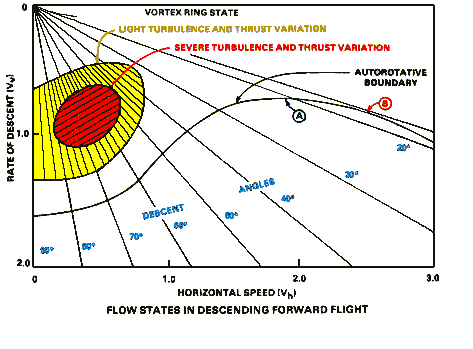

Glide and Rate of Descent in Autorotative Flight
Helicopter Airspeed is probably the most significant factor affecting rate of descent in autorotative flight.
Rate of descent is large at very low airspeeds; decreases to a minimum at some intermediate airspeed; then increases again at at faster speed.

Note that the rate of descent is highest at zero airspeed, decreasing to a minimum rate at point "A", and intermeadiate horizonal airspeed. The rate of descent then increases again and provides the shallowest possible flight path angle at point "B", where the degree angle line is tangent to the autorotative boundry line. this is the Best Horizontal Speed For Maximum Glide Distance.
Each type of helicopter has specific airspeeds (given in the autorotation chart or airspeeds listing in the POH) at which a power-off glide will cover maximum distance. this airspeed is usually at, or slightly above, normal cruise airspeed. Also, shown in these charts are airspeeds which will result in the slowest rate of descent. These airspeeds are usually at, or near, slow cruise airspeed.
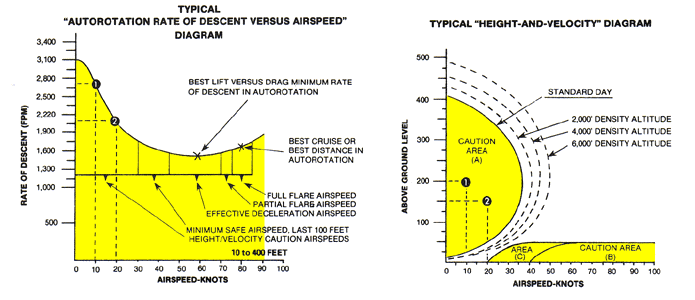
Specific airspeeds for maximum distance or slowest rate of descent are established on the basis of standard density altitude with aveerage weather and wind conditions and normal loading. When the helicopter is operated with excessive loads in high density altitude or strong, gusty wind conditions, best performance is achieved from a slightly increased airspeed during the descent. for autorotative flight in light winds and low-density altitude, best performance is achieved from a slight decrease in normal airspeed.
Following this general procedure of fitting airspeed to existing conditions, a pilot can achieve approximately the same glide angle to any set of circumstances and estimate his touchdown point. for example, the best glide ratio (max dist) for the average helicopter is about 4 feet of forward glide for 1 foot of descent. Ideal airspeed for minimum rate of descent is at slow cruise values and with a glide ratio of 3 feet forward to 1 foot descent. Above and below this airspeed, the rate of descent rapidly increases.
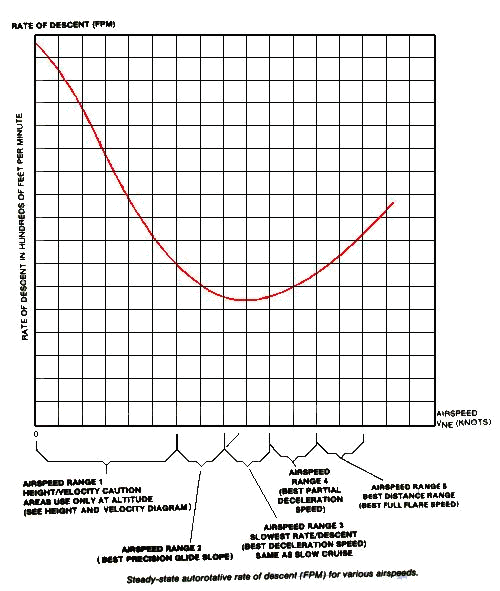
A study of the autorotation graphic shows typical rates of descent for the various airspeeds for steady state autorotation. This type of graph in a POH would give the basic information required for introduction to precision autorotation. Normally, the acceptable autorotation airspeed ranges for the various models of helicopters for pilots having average skills vary from slightly less than slow cruise values (Ranges 2 through 5 in both graphics).
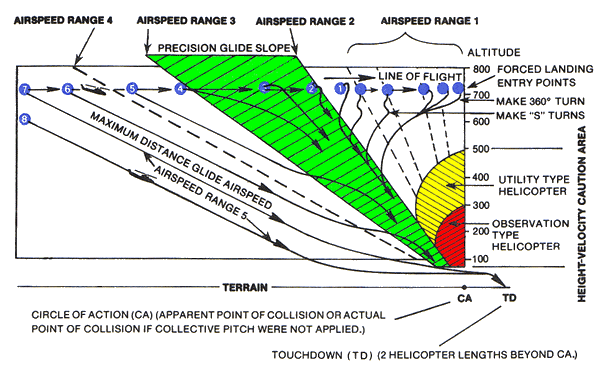
In airspeeds of range 2 to midpoint of range 3 note that a slight change of airspeed results in a large selection in rates of descent. Therefore, this is the best precision airspeed glideslope. A pilot in steady-state autorotative flight in this airspeed range may advance or retreat the point of ground contact noticeably by increasing or decreasing the airspeed by as Little As 5 Knots. Airspeeds of less than 2 yield increasingly high rates of descent.
The Last 100 Feet (Where Pilots Pull It Off or Mishaps Are Born)
For purposes of clarity, lets assume that the autoratation ends at 100 feet and that the power-off landing procedure begins there. The accepted method of executing a power-off landing for rotory-winged aircraft is to obtain a smooth trade-off of airspeed for lift during the last 100 feet. Ideally, beginning at 100 feet, airspeed is converted to additional lift by the Flare (or Deceleration). The Flare is so timed and applied that the rate of descent and the forward speed are reduced just before touchdown to the slowest rates possible for the existing conditions.
Potential energy Available For Power-Off Landing
At 100 feet, the pilot must begin spending stored flight energies; that is, the forward velocity of the helicopter and, just before touchtown, the rotational energy of the main rotor. At 100 feet, he can predict with accuracy the amount of potential energy (deceleration or cyclic lifting power) available for the landing. He can also predict the effectiveness of applying collective pitch to cushion the touchdown.
Rate of Descent And Groundspeed
All the heavy aerodynamic work of reducing the rate of descent and slowing the groundspeed should be the result of the pilot's effecting some sort of deceleration, down to approximately 15 feet. Thereafter, his use of collective pitch further slows (at times, delays) the descent and then cushions the touchdown.
Power-Off Landing Terms / Definitions
The following terms and definitions should be understood for the discussion of power-off landings in the next headings:
 Attitude Rotation - A pre-planned or scheduled change in aircraft attitude at some specific point in a maneuver sequence.
Attitude Rotation - A pre-planned or scheduled change in aircraft attitude at some specific point in a maneuver sequence.
 Flare (Deceleration)- A trade-off of airspeed for lift (or rotor RPM) while holding or maintaining a relatively continuous line of descent.
Flare (Deceleration)- A trade-off of airspeed for lift (or rotor RPM) while holding or maintaining a relatively continuous line of descent.
 Partial Flare (Deceleration)- A trade-off of airspeed for lift (or rotor RPM) which results in a moderate change to the line of flight.
Partial Flare (Deceleration)- A trade-off of airspeed for lift (or rotor RPM) which results in a moderate change to the line of flight.
 Full Flare (Deceleration)- A trade-off of airspeed for lift which results in a substantial change in the line of flight. In autorotation at the appropriate altitude, the descending line of flight is changed by converting airspeed to lift, so as to parrell the ground for some distance.
Full Flare (Deceleration)- A trade-off of airspeed for lift which results in a substantial change in the line of flight. In autorotation at the appropriate altitude, the descending line of flight is changed by converting airspeed to lift, so as to parrell the ground for some distance.
Note: The terms "Flare", "Partial Flare" and "Full Flare" do not apply to the attitude rotation per se, but to the change in lift and/or the change in the line of flight that results from the attitude rotation.
Conditions
This graphic will show the airspeed conditions at 100 feet, and the following paragraphs describe the landing sequences resulting from those airspeed conditions (We'll start with condition 5 working forward across the graphic) All of this is predictable at 100 feet:
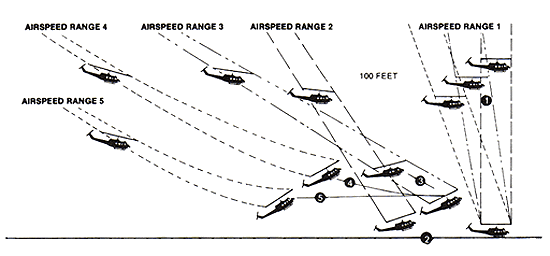
 Condition 5 -Exists at 100 feet with Airspeed Range 5. The helicopter is descending in a very narrow rotor profile to the line of descent. the helicopter is then encountering a large volume of air per second. This can produce exceptional lifting forces when the attitude is rotated smoothly and prograssively and the full rotor diameter profile is presented to (or against) the line of descending flight. This attitude rotation is usually accomplished at 30 to 60 feet, depending upon the aircraft.
Condition 5 -Exists at 100 feet with Airspeed Range 5. The helicopter is descending in a very narrow rotor profile to the line of descent. the helicopter is then encountering a large volume of air per second. This can produce exceptional lifting forces when the attitude is rotated smoothly and prograssively and the full rotor diameter profile is presented to (or against) the line of descending flight. This attitude rotation is usually accomplished at 30 to 60 feet, depending upon the aircraft.
 Condition 4 -Exists at 100 feet with Airspeed Range 4. The helicopter here is also descending in a very narrow rotor profile to the line of descent. A smooth and progressive attitude change (Flare), which presents a full rotor diameter profile to (or against) the line of descent, will alter the line of descent and add lift. When properly timed, this added lift will greatly reduce the rate of descent and forward airspeed prior to the initial collective pitch application. It may also be used (as stated above) to increase rotor RPM prior to collective pitch application.
Condition 4 -Exists at 100 feet with Airspeed Range 4. The helicopter here is also descending in a very narrow rotor profile to the line of descent. A smooth and progressive attitude change (Flare), which presents a full rotor diameter profile to (or against) the line of descent, will alter the line of descent and add lift. When properly timed, this added lift will greatly reduce the rate of descent and forward airspeed prior to the initial collective pitch application. It may also be used (as stated above) to increase rotor RPM prior to collective pitch application.
 Condition 3 -Exists at 100 feet with Airspeed Range 3. The helicopter is descending on slightly less than a full rotor diameter profile to the line of descent; Translational lift is near maximum effect; and the rate of descent is minimum. the pilot should know that a smooth and progressive rotation of attitude, which presents a full rotor diameter profile to (or against) the line of descent, will result in an effective deceleration.
Condition 3 -Exists at 100 feet with Airspeed Range 3. The helicopter is descending on slightly less than a full rotor diameter profile to the line of descent; Translational lift is near maximum effect; and the rate of descent is minimum. the pilot should know that a smooth and progressive rotation of attitude, which presents a full rotor diameter profile to (or against) the line of descent, will result in an effective deceleration.
 Condition 2 -Exists at 100 feet with Airspeed Range 2. The helicopter is descending on nearly a Full rotor diameter rofile. The pilot knows (or should know) that nothing will be gained by an attitude rotation; that he should hold a steady attitude to maintain the speed, at least down to 50 feet; and that, of the five conditions, this condition produces the longest ground run. Therefore, at about 50 feet, the pilot should begin a progressive attitude change until a slight rearward tilt of the rotor occurs just prior to the application of collective pitch. The attitude change will not supply additional lift, but it will add a rearward componant of lift during the pitch application. this will reduce the ground run.
Condition 2 -Exists at 100 feet with Airspeed Range 2. The helicopter is descending on nearly a Full rotor diameter rofile. The pilot knows (or should know) that nothing will be gained by an attitude rotation; that he should hold a steady attitude to maintain the speed, at least down to 50 feet; and that, of the five conditions, this condition produces the longest ground run. Therefore, at about 50 feet, the pilot should begin a progressive attitude change until a slight rearward tilt of the rotor occurs just prior to the application of collective pitch. The attitude change will not supply additional lift, but it will add a rearward componant of lift during the pitch application. this will reduce the ground run.
Condition 2 falls on the border line of the height/velocity diagram. Often a wind gradient and/or high density-altitude condition can then cause an increase in the rate of descent, thus increasing the lift demands on the collective pitch application. The resulting Mishap summary usually states that the damage was caused by a late and insufficient application of collective pitch. Actually, the error occurred earlier - at 100 feet. It was due to a lack of knowledge, cross-check, projection and prediction. When condition 2 is performed knowledgeably, with normal atmospherics and gross weights, it is considered a safe operation.
 Condition 1 -Exists at 100 feet with Airspeed Range 1. The helicopter is descending on a full rotor diameter profile to the line of descent. There is a high sink rate; no deceleration lift is possible. Due to a wind gradient, gusts, or wind shift, this condition may suddenly occur in the last 100 feet of descent. The entire rate of descent must be stopped by the application of collective pitch alone. Usually the lift produced is insufficient for safe landings.
Condition 1 -Exists at 100 feet with Airspeed Range 1. The helicopter is descending on a full rotor diameter profile to the line of descent. There is a high sink rate; no deceleration lift is possible. Due to a wind gradient, gusts, or wind shift, this condition may suddenly occur in the last 100 feet of descent. The entire rate of descent must be stopped by the application of collective pitch alone. Usually the lift produced is insufficient for safe landings.
Note: The full or partial flare (deceleration) is necessary for a zero ground run, and is Mandatory for helicopters having low rotor inertia with light unweighted blades and/or poor collective pitch effectiveness at termination.
 Back to Page One
Back to Page One
 Return to Dynamic Aerodynamics!
Return to Dynamic Aerodynamics!
 Return to Dynamic Flight
Return to Dynamic Flight
Copyright ©1999-2017 Dynamic Flight, Inc. All rights reserved.
Page Last Updated on: Nov-06-2017